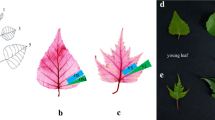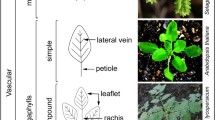Abstract
Simple to compound leaves occur in the Viola albida complex, which comprises the simple, finely serrate leaves of V. albida Palib., the deeply lobed leaves of V. albida var. takahashii (Nakai) Nakai, and the compound leaves of Viola chaerophylloides (Regel) W. Becker. To identify a correlation between the different leaf forms and the expression of several key genes with roles in leaf morphogenesis, the distinct leaf forms occurring within these species were generated by tissue culture of the V. chaerophylloides petiole, for comparison with wild-type leaves. Compound leaves were generally formed from a petiole explant taken close to the leaf blade, whereas simple leaves resulted from petiole explants taken close to the petiole base. KNOTTED-1 (VaKN1), SHOOTMERISTEMLESS (VaSTM), CUP-SHAPED COTYLEDON-2 (VaCUC2), and ASYMMETRIC LEAVES 1 (VaAS1), which are known to play key roles during compound leaf patterning and morphogenesis, were isolated and multiple sequence alignment revealed that there was no sequence variation at the amino acid level within each gene and between the three varieties. Phylogenetic analysis confirmed that the isolated genes were homologous to KN, STM, CUC2, and AS1. The expression of VaKN1, VaSTM, and VaCUC2 was significantly elevated in the in vitro-cultured deeply lobed and compound leaves, as well as in V. chaerophylloides and V. albida var. takahashii plants, but was very low in the in vitro-cultured simple leaves and V. albida plants. These findings demonstrated that elevated transcripts of VaKN1, VaSTM, and VaCUC2 lead to the development of compound and deeply lobed leaves in the V. albida complex.







Similar content being viewed by others
References
Bar M, Ori N (2014) Leaf development and morphogenesis. Development 141:4219–4230
Bharathan G, Goliber TE, Moore C, Kessler S, Pham T, Sinha NR (2002) Homologies in leaf form inferred from KNOXI gene expression during development. Science 296:1858–1860
Champagne C, Sinha N (2004) Compound leaves: equal to the sum of their parts? Development 131:4401–4412
Chitwood DH, Ranjan A, Kumar R, Ichihashi Y, Zumstein K, Headland LR, Ostria-Gallardo E, Aguilar-Martinez JA, Bush S, Carriedo L, Fulop D, Martinez CC, Peng J, Maloof JN, Sinha NR (2014) Resolving distinct genetic regulators of tomato leaf shape within a heteroblastic and ontogenetic context. Plant Cell 26:3616–3629
Chomczynski P, Sacchi N (1987) Single-step method of RNA isolation by acid guanidinium thiocyanate-phenol-chloroform extraction. Anal Biochem 162:156–159
Chuck G, Lincoln C, Hake S (1996) KNAT1 induces lobed leaves with ectopic meristems when over expressed in Arabidopsis. Plant Cell 8:1277–1289
Cronquist A (1988) The evolution and classification of flowering plants, 2nd ed. The New York Botanical Garden, Bronx, NY
Dkhar J, Pareek A (2014) What determines a leaf’s shape? EvoDevo 5:1–19
Doyle JA, Endress PK (2000) Morphological phylogenetic analysis of basal angiosperms: comparison and combination with molecular data. Int J Plant Sci 161:S121–S153
Efroni I, Eshed Y, Lifschitz E (2010) Morphogenesis of simple and compound leaves: a critical review. Plant Cell 22:1019–1032
Hareven D, Gutfinger T, Parnis A, Eshed Y, Lifschitz E (1996) The making of a compound leaf: genetic manipulation of leaf architecture in tomato. Cell 84:735–744
Hay A, Tsiantis M (2006) The genetic basis for differences in leaf form between Arabidopsis thaliana and its wild relative Cardamine hirsuta. Nat Genet 38:942–947
Hay A, Tsiantis M (2010) KNOX genes: versatile regulators of plant development and diversity. Development 137:3153–3165
Janssen BJ, Lund L, Sinha N (1998) Overexpression of a homeobox gene LeT6 reveals indeterminate features in the tomato compound leaf. Plant Physiol 117:771–786
Kim GT, Um TW (1995) Effects of gibberellic acid treatment on germination in a study for the utilization of wild herbaceous species. Kor J Environ Ecol 9: 56–61
Kim KS (1986) Studies of comparative morphology on the Korean Viola species. Ph. D thesis. Sung Kyun Kwan University, Republic of Korea (http://www.ndsl.kr/ndsl/commons/util/ndslOriginalView.do?dbt=TRKO&cn=TRKO200200013034&rn=&url=&pageCode=PG18)
Kim KS, Sun BY, Whang SS, Chung GH (1991) Biosystematic study on the genus Viola in Korea – comparative morphology of the Viola albida complex. Korean J Bot 34:229–238
Kim M, McCormick S, Timmermans M, Sinha N (2003) The expression domain of PHANTASTICA determines leaflet placement in compound leaves. Nature 425:102
Ko MK, Yang J, Jin YH, Lee CH, Oh BJ (1998) Genetic relationships of Viola species evaluated by random polymorphic DNA analysis. J Hortic Sci Biotechnol 73:601–605
Kumar P, Elsaidi HR, Zorniak B, Laurens E, Yang J, Bacchu V, Wang M, Wiebe LI (2016). Synthesis and Biological Evaluation of Iodoglucoazomycin (I‐GAZ), an Azomycin–Glucose Adduct with Putative Applications in Diagnostic Imaging and Radiotherapy of Hypoxic Tumors. Chem Med Chem 11(15):1638–45.
Lee CH, Han NY (1994) Effect of cold treatment on seed germination in Viola species native to Korea. J Kor Soc Hort Sci 12:342–343
Lincoln C, Long J, Yamaguchi J, Serikawa K, Hake S (1994) A KNOTTED1-like homeobox gene in Arabidopsis is expressed in the vegetative meristem and dramatically alters leaf morphology when overexpressed in transgenic plants. Plant Cell 6:1859–1876
Murashige T, Skoog F (1962) A revised medium for rapid growth and bioassay with tobacco tissue cultures. Physiol Plant 15:473–497
Piazza P, Bailey CD, Cartolano M, Krieger J, Cao J, Ossowski S, Schneeberger K, He F, de Meaux J, Hall N, MacLeod N, Filatov D, Hay A, Tsiantis M (2010) Arabidopsis thaliana leaf form evolved via loss of KNOX expression in leaves in association with selective sweep. Curr Biol 20:2223–2228
Pinto FL, Lindblad D (2010) A guide for in-house design of template-switch-based 5′ rapid amplification of cDNA and systems. Anal Biochem 397:222–232
Rast-Somssich MI, Broholm S, Jenkins H, Canales C, Vlad V, Kwantes M, Bilsborough G, DelloIoio R, Ewing RM, Laufs P, Huijser P, Ohno C, Heisler MG, Hay A, Tsiantis M (2016) Alternate wiring of a KNOXI genetic network underlies differences in leaf development of A. thaliana and C. hirsuta. Genes Dev 29:2391–2404
Sanger F, Nicklen S, Coulson AR (1977) DNA sequencing with chain-terminating inhibitors. Proc Natl Acad Sci U S A 74:5463–5467
Schmittgen TD, Livak KJ (2008) Analyzing real-time PCR data by the comparative C T method. Nat Protoc 3:1101–1108
Shani E, Burko Y, Ben-Yaakov L, Berger Y, Amsellem Z, Goldshmidt A, Sharon E, Ori N (2009) Stage-specific regulation of Solanum lycopersicum leaf maturation by class 1 KNOTTED1-LIKE HOMEOBOX proteins. Plant Cell 21:3078–3092
Soh H, Auh C, Soh WY, Han K, Kim D, Lee S, Rhee Y (2011) Gene expression changes in Arabidopsis seedlings during short to long term exposure to 3-D clinorotation. Planta 234:255–270
Taylor DW, Hickey LJ (1996) Evidence for and implications of an herbaceous origin of angiosperms. In: Taylor DW, Hickey LJ (eds) Flowering plant origin, evolution and phylogeny. Chapman & Hall, New York, pp 232–266
Tsukaya H (2005) Leaf shape: genetic controls and environmental factors. Intl J Dev Biol 49:547–555
Waites R, Hudson A (1995) PHANTASTICA: a gene required for dorsoventrality of leaves in Antirrhinum majus. Development 121:2143–2154
Whang SS (2006) Analysis of ITS DNA sequences of the Viola albida complex. Korean J Plant Res 19:628–633
Yoo KO, Jang SK (2010) Infrageneric relationships of Korean Viola based on eight chloroplast markers. J Syst Evol 48:474–481
Zimmermann W (1952) Main results of the ‘telome theory’. Paleobotanist 1:456–470
Acknowledgments
This paper was partly supported by “Research Base Construction Fund Support Program” funded by Chonbuk National University in 2016. The authors would like to thank the reviewers and the handling editor for helping us improve the quality of the manuscript.
Author information
Authors and Affiliations
Corresponding author
Additional information
Editor: Editor: Zhezhi Wang
Electronic supplementary material
ESM 1
(DOCX 24 kb)
Rights and permissions
About this article
Cite this article
Srikanth, K., Hill, R.S. & Whang, S.S. A correlation between leaf shape and its related key genes in Viola albida complex. In Vitro Cell.Dev.Biol.-Plant 55, 409–420 (2019). https://doi.org/10.1007/s11627-019-09975-5
Received:
Accepted:
Published:
Issue Date:
DOI: https://doi.org/10.1007/s11627-019-09975-5




